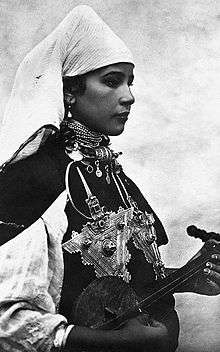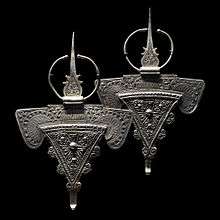Amazigh fibula
An Amazigh fibula (الخلالة الأمازيغية) is a fibula or brooch with symbolic importance in Amazigh heritage. Its use is widespread among numerous North African tribes. Its exact form is different from one tribe to another, but it consists essentially of a triangle beneath a ring or semicircle.[1][2]



Name
In the language of the Souss tribes, this piece is called tarazwit or tazarzit.[3][4] The word tazarzit is grammatically feminine, as are all words in this language that begin with a t. It seems that this word is derived from the Tamazight word azar, which means "hair;" this brooch is often woven into hair braids.
In the language of the Rifi tribes, and among most speakers of Amazigh languages, the brooch is called tisighnast, p. tisaaghns, which means "pin" and is derived from the root gh - n - s related to the concept of pinning or securing in all Amazigh languages.
In the Kabylie region of Algeria, the brooch is referred to as an afzim (tafzimt) or abzim (tabzimt), from the Arabic word ibziim (إبزيم), "buckle."[5]
In Moroccan Darija, it is known by the name bazima (بزيمة, also from ibziim) or khalaala (خلالة) katfiya (كتفية).
Uses
Large brooches are often used decoratively, but medium-sized brooches also exist and are often used as pins. Small brooches are often used in hair braids or as jewelry worn over the forehead. These days, the triangular Amazigh brooch is often worn to symbolize chastity and honor.
The shape of this triangular brooch has also become a popular decorative motif.
References
- Rabaté, Marie-Rose; Goldenberg, André; Thau, Jean-Louis (1999). Bijoux du Maroc du Haut Atlas à la Méditerranée, depuis le temps des juifs jusqu'à la fin du XXe siècle (in French). Eddif. ISBN 978-2-7449-0081-5.
- Laurent, Fondation Pierre Bergé-Yves Saint (2014). Femmes berbères du Maroc (in French). Artlys. ISBN 978-2-85495-575-0.
- "Marché de l'argent: Les artisans bijoutiers s'éteignent doucement". L'Economiste (in French). 2015-02-06. Retrieved 2020-02-28.
- "Agadir/Artisanat: Un salon pour booster la filière". L'Economiste (in French). 2016-12-30. Retrieved 2020-02-28.
- "Traduction : agrafe - Dictionnaire français-arabe Larousse". Archived from the original on 3 April 2019. Retrieved 2020-02-11.